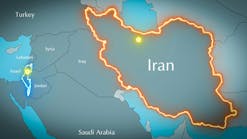US Tenth District 4Q energy activity dropped, outlook dim
Energy activity in the Tenth District dropped further and expectations for future activity continued to decline, a recent survey by the Federal Reserve Bank of Kansas City.
“District energy activity continued to decrease through 2019 fourth-quarter and most firms do not expect drilling activity to pick up in the near-term,” said Chad Wilkerson, Oklahoma City Branch executive and economist at the Federal Reserve Bank of Kansas City. “However, slightly more firms expect their cash flow to be higher next year than expect it to be lower.”
The Kansas City Fed's quarterly Tenth District Energy Survey provides information on current and expected activity among energy firms in the Tenth District. The survey monitors oil and gas-related firms located and/or headquartered in the Tenth District, with results based on total firm activity.
Survey results reveal changes in several indicators of energy activity, including drilling, capital spending, and employment. Firms also indicate projections for oil and gas prices. All results are diffusion indexes – the percentage of firms indicating increases minus the percentage of firms indicating decreases.
Survey results
Tenth District energy activity dropped further in the fourth quarter of 2019, as indicated by firms contacted Dec. 16-31, 2019.
On quarter-over-quarter basis, the drilling and business activity index fell from -23 to -48, indicating a continued, significant decrease in activity following a slight expansion earlier in 2019. However, the revenues index improved slightly, the wages and benefits index remained positive, and the employment index was flat. The supplier delivery time, profits, employee hours, and access to credit indexes all declined.
Most year-over-year indexes decreased as well. The year-over-year drilling and business activity index deteriorated further, from -21 to -50. Indexes for total revenues, capital expenditures, delivery time, profits, employment, and employee hours declined again in the fourth quarter. The year-over-year index for access to credit also turned negative. Only the year-over-year index for wages and benefits remained slightly positive.
Expectation indexes remained mostly negative. The future drilling and business activity index was -16, following a reading of -21 in Q3. The future capital expenditures, delivery time, profits, employment, employee hours, and access to credit indexes decreased again in Q4. The future wages and benefits index also turned negative.
On the other hand, the future profits index was flat, and the future revenues index expanded. Price expectations for oil and natural gas liquids eased slightly compared to the previous quarter, but remained positive. However, price expectations for natural gas fell.
Firms reported that oil prices needed to be on average $65/bbl for substantial increases in drilling to occur, down slightly from six months ago but higher than both current prices and prices expected over the next year.
Summary of special questions
Firms were again asked what they expected oil and natural gas prices to be in six months, one year, two years, and five years. Expected oil prices were slightly higher than Q3 2019, but similar to Q1 2019 price expectations.
The average expected WTI prices per barrel were $60, $62, $65, and $71, respectively. Expectations for natural gas prices decreased from last quarter. The average expected Henry Hub natural gas prices per million Btu were $2.38, $2.49, $2.69, and $3.09, respectively.
Firms were also asked about their cash flow expectations for 2020 compared to 2019. Nearly 37% of surveyed firms indicated they anticipate higher cash flow for 2020 compared to 2019, while 33% expect it will be down, and 30% expect no material change.
Finally, respondents were asked in what quarter they expect the US rig count to begin rising again. Over 20% predicted an uptick in rig counts in Q2 2020 and 25% expected the rig count to increase in Q3 2020. However, over 33% reported they do not believe the rig count will increase in 2020 and listed timeframes extending into 2021 or later.
Selected energy comments
“We have an abundant supply of natural gas. The shale production has produced a lot of gas with the oil. In some instances, companies have had to pay people to take the gas (negative price). We need more infrastructure (pipelines).”
“I see a stable supply of oil and limited demand growth.”
“Abundant supply of oil and there is lots of spare capacity in the world to produce more oil.”
“It seems like US shale is the swing producer of crude and that a long-term price of $65 will keep the market balanced for the foreseeable future.”
“Middle East conflicts/demand are driving our expectations.”
“OPEC+ desires a higher price and have made cuts to achieve the same. Markets are slowly reaching a balance.”
“The mid-continent infrastructure is fading rapidly. No people, no services, no investment, no oil.”
“New technology and techniques, along with better coordination with the drilling team, have decreased completion times.”
“An uptick in pricing will lead to a small pickup [in rig count]. There are a few on the sidelines who’ve waited for price stability.”
“Current rig efficiency should keep a large recovery in rig count from increasing anytime soon.”
“Credit is drying up for large exploration companies. Less capital is on hand for exploration.”
“Production declines will push E&P customers to start to complete previously drilled wells and start to build inventory of uncompleted wells.”


